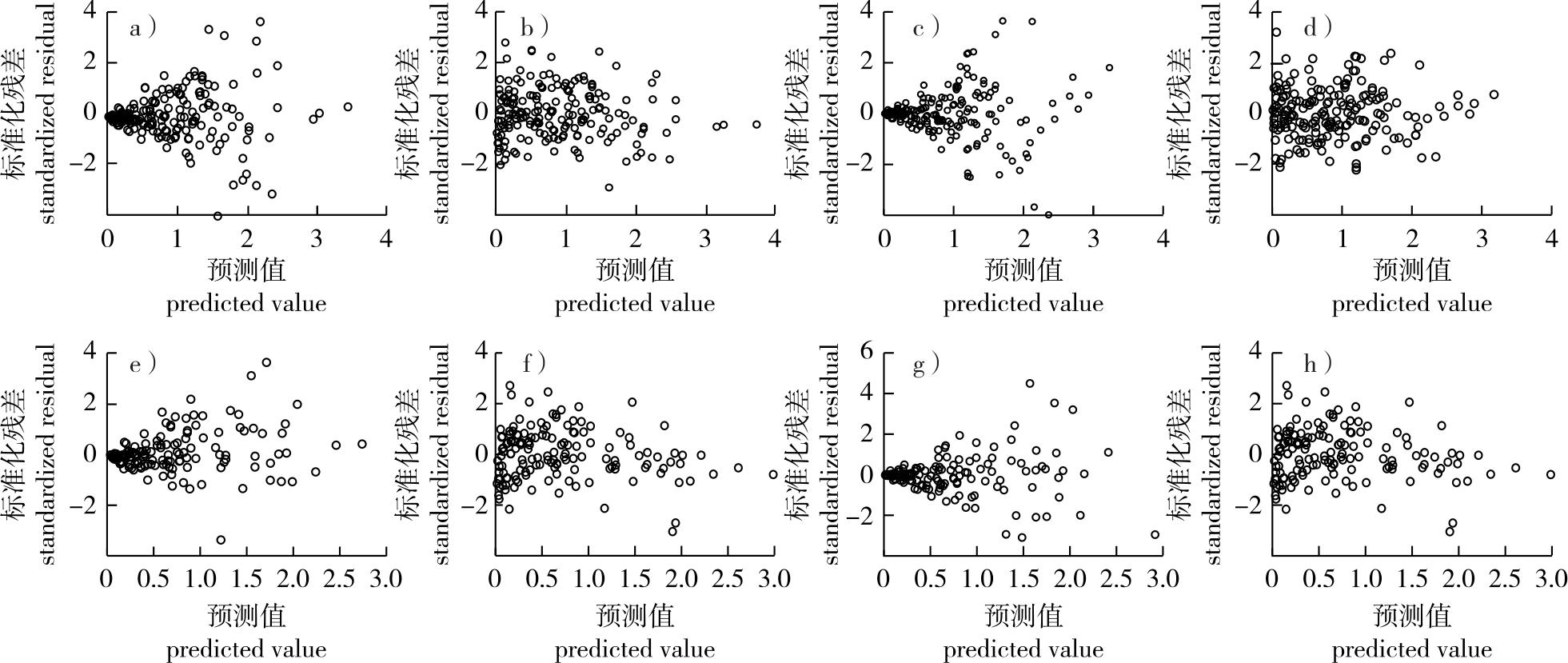【目的】以大兴安岭落叶松为研究对象,基于胸高形率、正形率以及地面形率,分别构建含有不同形率的单木材积模型,并与传统的一元和二元材积模型以及东北地区落叶松部颁二元材积模型进行比较分析。【方法】基于落叶松实测数据,将树干不同高度处的一系列胸高形率、正形率和地面形率引入传统材积模型中,分别构建含有不同形率的二元和三元单木材积模型,引入方差函数消除模型拟合时产生的异方差现象。选用平均绝对误差(MAE)、均方根误差(RMSE)、相对均方根误差(RMSE%)、决定系数(R2)、赤池信息准则(AIC)作为模型的评价指标,对各模型进行拟合与检验分析。【结果】①引入相对树高50%处的胸高形率,构建的二元和三元模型拟合效果最好,其中引入胸高形率的三元材积模型较二元材积方程的RMSE降低44.4%;②引入相对树高50%处正形率所构建的三元材积模型效果最佳,较引入正形率的二元材积模型的RMSE降低23.1%;③对于地面形率来说,三元材积模型的变量取相对树高60%时模型拟合效果最好,二元材积模型的变量取相对树高50%时模型拟合效果最好,引入地面形率的三元材积模型比二元材积模型RMSE降低32.5%;④与东北地区使用的落叶松部颁材积方程相比,引入胸高形率的三元材积模型RMSE、MAE、RMSE%分别降低 62.85%、65.02%、67.14%。含有胸高形率的三元材积模型相对于传统二元材积方程RMSE降低60.41%。【结论】形率因子是重要的干形指标,无论是胸高形率、正形率还是地面形率引入传统材积模型中均能提高单木材积预测精度。含有胸高形率的三元立木材积模型预测效果最好。因此,推荐使用该模型预测大兴安岭落叶松的单木材积。
【Objective】This study took the Larix gmelinii in the Greater Khingan Mountains as the research subject. Based on breast height form quotient, normal form quotient, and ground form quotient, individual tree volume models incorporating different form factors were constructed. These models were then compared and analyzed against traditional one-variable and two-variable volume models, as well as the two-variable volume model for L. gmelinii in Northeast China.【Method】Based on the measured data of L. gmelinii, a series of breast height form quotients, normal form quotients, and ground form quotients at different heights of the trunk were introduced into the traditional volume model. One-variable and two-variable tree volume models with different form quotients were constructed, respectively, and variance functions were introduced to eliminate the heteroscedasticity in the fitting process of each volume model. The mean absolute error (MAE), root mean square error (RMSE), relative root mean square error (RMSE%), determination coefficient (R2), and Akaike information criterion (AIC) were used as evaluation indexes to fit and analyze each model.【Result】(1) The two-variable and three-variable models constructed with the introduction of the breast height form quotient at 50% relative tree height fitted best, with the three-variable tree volume model reducing the RMSE by 44.4% compared to the two-variable tree volume equation. (2) The three-variable volume model constructed by introducing the normal form quotient,at 50% of the relative tree height performed the best, reducing the RMSE by 23.1% compared to the two-variable volume model that incorporated the ground form quotient. (3) For the ground form quotient, the three-variable volume model achieved the best fit when the variable was set at 60% of the relative tree height, while the binary volume model performed optimally when the variable was set at 50% of the relative tree height. The three-variable volume model incorporating the ground form quotient reduced the RMSE by 32.5% compared to the two-variable volume model. (4) Compared to the two-variable volume equation for Larix gmelinii used in Northeast China, the three-variable volume model incorporating the breast height form quotient reduced the RMSE, MAE, and RMSE% by 62.85%, 65.02%, and 67.14%, respectively. The three-variable volume model containing the breast height form quotient reduced the RMSE by 60.41% compared to the traditional two-variable tree volume equations.【Conclusion】The form quotient is an important index of stem form, and the introduction of breast height form quotient, normal form quotient, and ground form quotient into the traditional volume models can improve the accuracy of predicting tree volume. The three-variable tree volume model has the best prediction effect with the introduction of the breast height form quotient. Therefore, it is recommended to use this model to predict the tree stem volume of L. gmelinii in the region in the future.
 PDF(1638 KB)
PDF(1638 KB)


 PDF(1638 KB)
PDF(1638 KB)
 PDF(1638 KB)
PDF(1638 KB)
